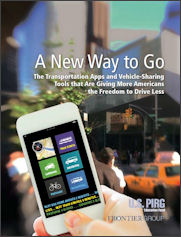Recent innovations in technology and social networking are transforming America’s transportation landscape, concludes a report by the U.S. PIRG Education Fund and Frontier Group, “A New Way to Go.” Smart phones and mobile connectivity have made possible a whole range of new services that allow people — especially the young people who most fervently adopt the technology — to rely less upon automobiles to get around.
Among the services flooding the marketplace: carsharing, bikesharing, ridesharing, taxi hailing, real-time transportation information and apps that allow people to plan trips using several modes of transportation. Little of this is new to Bacon’s Rebellion readers. I have been chronicling the proliferation of these services for years. But the PIRG report provides an excellent summary of what’s out there, documents how it is affecting transportation and recommends policy changes. What becomes clear is that the whole is greater than sum of its individual parts.
Some factoids:
- Mobile phone ownership. The percentage of adults who own a cell phone now numbers 88%. Roughly half own smart phones, which did not exist a decade ago.
- Carshare. As of 2012, more than 800,000 Americans were members of carsharing services such as Zipcar and City Carshare, sharing a combined fleet of more than 12,000 vehicles. New peer-to-peer networks enable individuals to rent out their own, unused vehicles to people looking for a car.
- Bikeshare. More than 30 U.S. cities now have programs where subscribers can access bicycles by the minute or by subscription. New York City’s Citibike program has enlisted 70,000 annual members.
- Real-time transportation data. The majority of U.S. transit systems have apps that allow riders to track the progress of trains and buses in real time.
Each carsharing vehicle replaces nine to 13 privately-owned vehicles, and carshare participants reduce reduce their driving by 27% to 56%. One quarter of them sell a vehicle after joining a carsharing group; another quarter forego vehicle purchases. A Chicago study found that the introduction of real-time bus location information increased weekday bus ridership. A 2013 survey of Washington, D.C., bikeshare riders found that one quarter had reduced the number of miles driven, and 5% had sold a personal vehicle.
No one service is decisive but the multiplicity of services is transformative. The creation of a wide variety of options — over and above the buses, rail and streetcars — makes more people feel comfortable about jettisoning a car or going entirely “car free.” A big motivator: households can reduce spending on transportation, which accounts for roughly one-sixth of all consumer spending.
All of these innovations have arisen without government assistance, I would note, and getting government involved could be the kiss of death if it leads to unnecessary regulation. However, PIRG suggests there are some ways that government can help:
- Facilitate the use of IT by providing open access to transit scheduling, ensuring wi-fi or cellular network access on all transit vehicles and creating multimodal connections with the emerging transportation services. (Example: Install bikeshare stations near Metro stops.)
- Modernize regulations to accommodate carsharing, bikesharing, ridesharing and other transportation services. (I would add: bust up the transit and taxi oligopolies and encourage jitney services.
- Embrace a multi-modal future by breaking down outdated, mode-specific silos in transportation agencies and financing.
Question One: Is anyone in Virginia state government dialing back forecasts of Vehicle Miles Traveled on roads and highways in recognition that these new technologies are changing driving behavior? Or will the bureaucratic leviathan lumber onward, pushing expensive transportation projects conceived ten, even 20, years ago?
Question Two: Out of the roughly $800 million the Commonwealth of Virginia will be able to spend yearly on transportation construction thanks to the McDonnell tax increase, how much will be steered to roads and highways, how much to transit and rail, and how much to supporting these new technologies? Is anyone analyzing the Return on Investment for supporting these IT-driven services vs. the ROI on new roads and rail lines?
Question Three: Every car/bike/ridesharing entrepreneur is setting up shop in the Washington region, which is one of the nation’s largest (and most congested) markets. Are transportation planners in Richmond, Hampton Roads and other regions doing anything to invite the new services to their regions?



